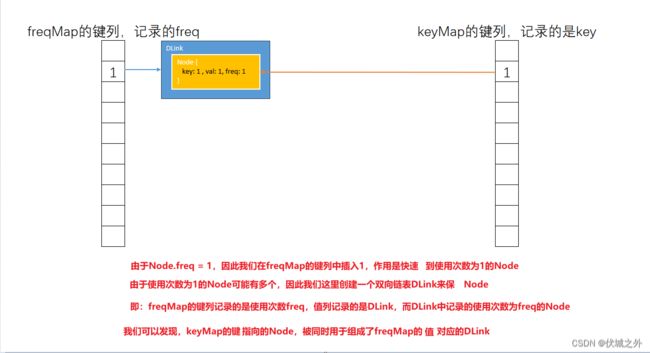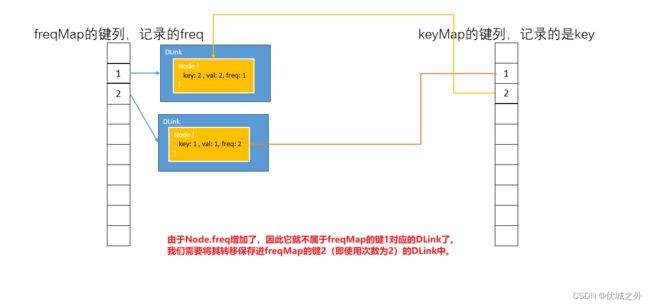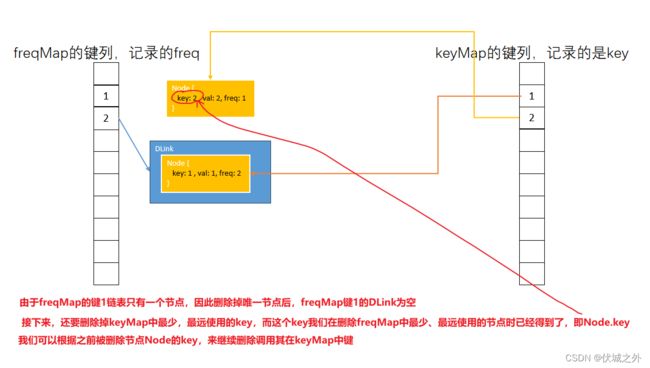LeetCode - 460 LFU缓存(Java & JS & Python)
题目来源
460. LFU 缓存 - 力扣(LeetCode)
题目描述
请你为 最不经常使用(LFU)缓存算法设计并实现数据结构。
实现 LFUCache 类:
- LFUCache(int capacity) - 用数据结构的容量 capacity 初始化对象
- int get(int key) - 如果键 key 存在于缓存中,则获取键的值,否则返回 -1 。
- void put(int key, int value) - 如果键 key 已存在,则变更其值;如果键不存在,请插入键值对。当缓存达到其容量 capacity 时,则应该在插入新项之前,移除最不经常使用的项。在此问题中,当存在平局(即两个或更多个键具有相同使用频率)时,应该去除 最久未使用 的键。
为了确定最不常使用的键,可以为缓存中的每个键维护一个 使用计数器 。使用计数最小的键是最久未使用的键。
当一个键首次插入到缓存中时,它的使用计数器被设置为 1 (由于 put 操作)。对缓存中的键执行 get 或 put 操作,使用计数器的值将会递增。
函数 get 和 put 必须以 O(1) 的平均时间复杂度运行。
示例
输入
["LFUCache", "put", "put", "get", "put", "get", "get", "put", "get", "get", "get"] [[2], [1, 1], [2, 2], [1], [3, 3], [2], [3], [4, 4], [1], [3], [4]]
输出
[null, null, null, 1, null, -1, 3, null, -1, 3, 4]
解释
// cnt(x) = 键 x 的使用计数
// cache=[] 将显示最后一次使用的顺序(最左边的元素是最近的)
LFUCache lfu = new LFUCache(2);
lfu.put(1, 1); // cache=[1,_], cnt(1)=1
lfu.put(2, 2); // cache=[2,1], cnt(2)=1, cnt(1)=1
lfu.get(1); // 返回 1
// cache=[1,2], cnt(2)=1, cnt(1)=2
lfu.put(3, 3); // 去除键 2 ,因为 cnt(2)=1 ,使用计数最小
// cache=[3,1], cnt(3)=1, cnt(1)=2
lfu.get(2); // 返回 -1(未找到)
lfu.get(3); // 返回 3
// cache=[3,1], cnt(3)=2, cnt(1)=2
lfu.put(4, 4); // 去除键 1 ,1 和 3 的 cnt 相同,但 1 最久未使用
// cache=[4,3], cnt(4)=1, cnt(3)=2
lfu.get(1); // 返回 -1(未找到)
lfu.get(3); // 返回 3
// cache=[3,4], cnt(4)=1, cnt(3)=3
lfu.get(4); // 返回 4
// cache=[3,4], cnt(4)=2, cnt(3)=3
提示
- 1 <= capacity <= 104
- 0 <= key <= 105
- 0 <= value <= 109
- 最多调用 2 * 10^5 次 get 和 put 方法
题目解析
LFU缓存可以通过:两个哈希表(Map结构) + 双向链表来实现。
我们可以定义两个哈希表keyMap和freqMap,其中:
- keyMap的键是"本题key",值为"双向链表节点node"
- freqMap的键是"本题key的使用次数freq",值为”对应使用次数freq的key对应的node组成的双向链表“
而双向链表节点node用于记录key的如下信息:
- key:本题的key
- val:本题的value
- freq:对应key使用次数
可能上面说法比较晦涩,下面通过图示来说:
以上就是两个哈希Map,以及双向链表完成LFU缓存的逻辑。
上面逻辑中,有一个问题,那么就是每次LFU容量不足时,我们需要删除掉最少、最远使用的key,那么首先如何找到最少使用次数的key呢?
上面图示中,我们是通过人眼识别出freqMap键列中最小的键,即为最少使用次数。
那么代码该如何实现呢?
我们可以定义一个全局变量(或者类静态变量)minFreq来记录最少使用次数,而minFreq的更新有如下时机:
- 1、put新增操作一定会带来一个使用次数freq=1的键,且此新键的使用次数1一定是最少的,此时我们可以更新minFreq=1
- 2、get和put更新操作会新增对应key的使用次数,因此在新增使用次数后,该key需要从对应使用次数的DLink中去除,如果对应DLink只有该key对应节点,且对应DLink是最少使用次数对应的容器链表,那么删除key后,该DLInk就为空,那么最少使用次数的key就没了。此时我们可以直接将minFreq++,因为如果当前key在新增使用次数前是唯一的最少使用次数key,那么当前key新增使用次数后,依旧是最少使用次数的key。而minFreq就是当前key新增使用次数前的使用次数。
Java算法源码
import java.util.HashMap;
class LFUCache {
/** 双向链表节点 */
static class Node {
/** 记录本题的键 */
int key;
/** 记录本题的值 */
int val;
/** 记录该键被访问的次数 */
int freq;
/** 当前节点的上一个节点 */
Node prev;
/** 当前节点的下一个节点 */
Node next;
public Node(int key, int val, int freq) {
this.key = key;
this.val = val;
this.freq = freq;
this.prev = null;
this.next = null;
}
}
/** 双向链表 */
static class Link {
/** 链表中节点个数 */
int size;
/** 链表头节点 */
Node head;
/** 链表尾节点 */
Node tail;
public Link() {
this.size = 0;
this.head = null;
this.tail = null;
}
/**
* 尾插
*
* @param node 要被插入的节点
*/
public void addLast(Node node) {
if (this.size == 0) {
// 空链表,则node节点插入后,即为头、尾节点
this.head = node;
this.tail = node;
} else {
// 非空链表,则node节点插入到tail节点后面
this.tail.next = node;
node.prev = this.tail;
this.tail = node;
}
this.size++;
}
/**
* 删除指定节点
*
* @param node 要删除的节点
*/
public void remove(Node node) {
// 空链表没有节点,所以无法删除
if (this.size == 0) return;
if (this.size == 1) {
// 链表只有一个节点,则删除完后,变为空链表
this.head = null;
this.tail = null;
} else if (this.head == node) {
// 如果要删除的节点是头节点
this.head = this.head.next;
this.head.prev = null;
} else if (this.tail == node) {
// 如果要删除的节点是尾节点
this.tail = this.tail.prev;
this.tail.next = null;
} else {
// 如果要删除的节点是中间节点
node.prev.next = node.next;
node.next.prev = node.prev;
}
this.size--;
}
}
/** keyMap用于记录key对应的node */
HashMap keyMap;
/** freqMap的key是访问次数,value是具有相同访问次数的key对应的node组成的链表,链表头是最远访问的,链表尾是最近访问的 */
HashMap freqMap;
/** LFU缓存中能记录的最多key的数量 */
int capacity;
/** LFU缓存中所有的key中最少的访问次数 */
int minFreq;
public LFUCache(int capacity) {
this.keyMap = new HashMap<>();
this.freqMap = new HashMap<>();
this.capacity = capacity;
this.minFreq = 0;
}
public int get(int key) {
if (this.keyMap.containsKey(key)) {
// 存在对应key,则返回对应val
Node node = this.keyMap.get(key);
incNodeFreq(node); // get操作会新增对应key的访问次数
return node.val;
} else {
// 不存在对应key,则返回-1
return -1;
}
}
public void put(int key, int value) {
// 对应key已存在,则为更新场景
if (this.keyMap.containsKey(key)) {
Node node = this.keyMap.get(key);
incNodeFreq(node); // 更新操作会增加对应key的访问次数
node.val = value;
}
// 对应key不存在,则为新增场景
else {
// 先判断容量是否超过,keyMap的key数量就是LFU缓存中记录的key数量
if (this.keyMap.size() >= this.capacity) {
Link link = this.freqMap.get(this.minFreq);
int removeKey = link.head.key;
link.remove(link.head); // 最少访问次数所在链表的头节点,即为:最少、最远访问的key,容量不足时,需要优先删除它
this.keyMap.remove(removeKey); // 注意,不要遗漏将keyMap中该key删除
}
// 新增key,则对应key的访问次数为1,且为最少访问次数
this.minFreq = 1;
Node node = new Node(key, value, this.minFreq);
// 将新增key对应的node加入到freqMap,和keyMap中
this.freqMap.putIfAbsent(this.minFreq, new Link());
this.freqMap.get(this.minFreq).addLast(node);
this.keyMap.put(key, node);
}
}
/**
* 增加key的访问次数
*
* @param node key对应的node
*/
public void incNodeFreq(Node node) {
// 由于key的访问次数增加,因此要从原访问次数的链表中删除
this.freqMap.get(node.freq).remove(node);
// 如果原链表删除当前key对应的节点后为空,且原链表对应的访问次数就是最少访问次数
if (this.freqMap.get(node.freq).size == 0 && node.freq == this.minFreq) {
// 则最少访问次数对应的key没有了,因此最少访问次数++(即当前key访问次数++后,当前key的访问次数还是最少访问次数)
this.minFreq++;
}
// 当前key访问次数++
node.freq++;
// 将当前key对应的node转移到对应增加后的访问次数对应的链表尾部(最近访问)
this.freqMap.putIfAbsent(node.freq, new Link());
this.freqMap.get(node.freq).addLast(node);
}
}
JS算法源码
/** 双向链表节点 */
class Node {
constructor(key, val, freq) {
/** 记录本题的键 */
this.key = key;
/** 记录本题的值 */
this.val = val;
/** 记录该键被访问的次数 */
this.freq = freq;
/** 当前节点的上一个节点 */
this.prev = null;
/** 当前节点的下一个节点 */
this.next = null;
}
}
/** 双向链表 */
class Link {
constructor() {
/** 链表中节点个数 */
this.size = 0;
/** 链表头节点 */
this.head = null;
/** 链表尾节点 */
this.tail = null;
}
/**
* 尾插
* @param {*} node 要被插入的节点
*/
addLast(node) {
if (this.size == 0) {
// 空链表,则node节点插入后,即为头、尾节点
this.head = node;
this.tail = node;
} else {
// 非空链表,则node节点插入到tail节点后面
this.tail.next = node;
node.prev = this.tail;
this.tail = node;
}
this.size++;
}
/**
* 删除指定节点
* @param {*} node 要删除的节点
*/
remove(node) {
// 空链表没有节点,所以无法删除
if (this.size == 0) return;
if (this.size == 1) {
// 链表只有一个节点,则删除完后,变为空链表
this.head = null;
this.tail = null;
} else if (this.head == node) {
// 如果要删除的节点是头节点
this.head = this.head.next;
this.head.prev = null;
} else if (this.tail == node) {
// 如果要删除的节点是尾节点
this.tail = this.tail.prev;
this.tail.next = null;
} else {
// 如果要删除的节点是中间节点
node.prev.next = node.next;
node.next.prev = node.prev;
}
this.size--;
}
}
/**
* @param {number} capacity
*/
var LFUCache = function (capacity) {
/** keyMap用于记录key对应的node */
this.keyMap = new Map();
/** freqMap的key是访问次数,value是具有相同访问次数的key对应的node组成的链表,链表头是最远访问的,链表尾是最近访问的 */
this.freqMap = new Map();
/** LFU缓存中能记录的最多key的数量 */
this.capacity = capacity;
/** LFU缓存中所有的key中最少的访问次数 */
this.minFreq = 0;
};
/**
* @param {number} key
* @return {number}
*/
LFUCache.prototype.get = function (key) {
if (this.keyMap.has(key)) {
// 存在对应key,则返回对应val
const node = this.keyMap.get(key);
this.incNodeFreq(node); // get操作会新增对应key的访问次数
return node.val;
} else {
// 不存在对应key,则返回-1
return -1;
}
};
/**
* @param {number} key
* @param {number} value
* @return {void}
*/
LFUCache.prototype.put = function (key, value) {
// 对应key已存在,则为更新场景
if (this.keyMap.has(key)) {
const node = this.keyMap.get(key);
this.incNodeFreq(node); // 更新操作会增加对应key的访问次数
node.val = value;
}
// 对应key不存在,则为新增场景
else {
// 先判断容量是否超过,keyMap的key数量就是LFU缓存中记录的key数量
if (this.keyMap.size >= this.capacity) {
const link = this.freqMap[this.minFreq];
const removeKey = link.head.key;
link.remove(link.head); // 最少访问次数所在链表的头节点,即为最少、最远访问的key,容量不足时,需要优先删除它
this.keyMap.delete(removeKey); // 注意,不要遗漏将keyMap中该key删除
}
// 新增key,则对应key的访问次数为1,且为最少访问次数
this.minFreq = 1;
// 将新增key对应的node加入到freqMap,和keyMap中
const node = new Node(key, value, this.minFreq);
if (this.freqMap[this.minFreq] == undefined) {
this.freqMap[this.minFreq] = new Link();
}
this.freqMap[this.minFreq].addLast(node);
this.keyMap.set(key, node);
}
};
/**
* 增加key的访问次数
* @param {*} node key对应的node
*/
LFUCache.prototype.incNodeFreq = function (node) {
// 由于key的访问次数增加,因此要从原访问次数的链表中删除
this.freqMap[node.freq].remove(node);
// 如果原链表删除当前key对应的节点后为空,且原链表对应的访问次数就是最少访问次数
if (this.freqMap[node.freq].size == 0 && node.freq == this.minFreq) {
// 则最少访问次数对应的key没有了,因此最少访问次数++(即当前key访问次数++后,当前key的访问次数还是最少访问次数)
this.minFreq++;
}
// 当前key访问次数++
node.freq++;
// 将当前key对应的node转移到对应增加后的访问次数对应的链表尾部(最近访问)
if (this.freqMap[node.freq] == undefined) {
this.freqMap[node.freq] = new Link();
}
this.freqMap[node.freq].addLast(node);
};
Python算法源码
# 双向链表节点
class Node:
def __init__(self, key, val, freq):
"""
:param key: 记录本题的键
:param val: 记录本题的值
:param freq: 记录该键被访问的次数
"""
self.key = key
self.val = val
self.freq = freq
self.prev = None
self.next = None
# 双向链表
class Link:
def __init__(self):
self.size = 0
self.head = None
self.tail = None
def addLast(self, node):
"""
尾插
:param node: 要被插入的节点
"""
if self.size == 0:
# 空链表,则node节点插入后,即为头、尾节点
self.head = node
self.tail = node
else:
# 非空链表,则node节点插入到tail节点后面
self.tail.next = node
node.prev = self.tail
self.tail = node
self.size += 1
def remove(self, node):
"""
删除指定节点
:param node: 要删除的节点
"""
if self.size == 0:
# 空链表没有节点,所以无法删除
return
if self.size == 1:
# 链表只有一个节点,则删除完后,变为空链表
self.head = None
self.tail = None
elif self.head == node:
# 如果要删除的节点是头节点
self.head = self.head.next
self.head.prev = None
elif self.tail == node:
# 如果要删除的节点是尾节点
self.tail = self.tail.prev
self.tail.next = None
else:
# 如果要删除的节点是中间节点
node.prev.next = node.next
node.next.prev = node.prev
self.size -= 1
class LFUCache(object):
def __init__(self, capacity):
self.keyMap = {} # keyMap用于记录key对应的node
self.freqMap = {} # freqMap的key是访问次数,value是具有相同访问次数的key对应的node组成的链表,链表头是最远访问的,链表尾是最近访问的
self.capacity = capacity # LFU缓存中能记录的最多key的数量
self.minFreq = 0 # LFU缓存中所有的key中最少的访问次数
def get(self, key):
if key in self.keyMap:
# 存在对应key,则返回对应val
node = self.keyMap[key]
self.incNodeFreq(node) # get操作会新增对应key的访问次数
return node.val
else:
# 不存在对应key,则返回-1
return -1
def put(self, key, value):
if key in self.keyMap:
# 对应key已存在,则为更新场景
node = self.keyMap[key]
self.incNodeFreq(node) # 更新操作会增加对应key的访问次数
node.val = value
else:
# 对应key不存在,则为新增场景
# 先判断容量是否超过,keyMap的key数量就是LFU缓存中记录的key数量
if len(self.keyMap) >= self.capacity:
link = self.freqMap[self.minFreq]
removeKey = link.head.key
link.remove(link.head) # 最少访问次数所在链表的头节点,即为:最少、最远访问的key,容量不足时,需要优先删除它
self.keyMap.pop(removeKey) # 注意,不要遗漏将keyMap中该key删除
# 新增key,则对应key的访问次数为1,且为最少访问次数
self.minFreq = 1
node = Node(key, value, self.minFreq)
# 将新增key对应的node加入到freqMap,和keyMap中
self.freqMap.setdefault(self.minFreq, Link())
self.freqMap.get(self.minFreq).addLast(node)
self.keyMap[key] = node
def incNodeFreq(self, node):
"""
增加key的访问次数
:param node: key对应的node
"""
# 由于key的访问次数增加,因此要从原访问次数的链表中删除
self.freqMap[node.freq].remove(node)
# 如果原链表删除当前key对应的节点后为空,且原链表对应的访问次数就是最少访问次数
if self.freqMap[node.freq].size == 0 and node.freq == self.minFreq:
# 则最少访问次数对应的key没有了,因此最少访问次数++(即当前key访问次数++后,当前key的访问次数还是最少访问次数)
self.minFreq += 1
# 当前key访问次数++
node.freq += 1
# 将当前key对应的node转移到对应增加后的访问次数对应的链表尾部(最近访问)
self.freqMap.setdefault(node.freq, Link())
self.freqMap[node.freq].addLast(node)









